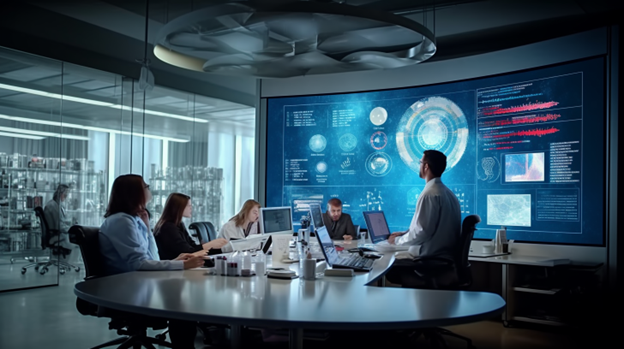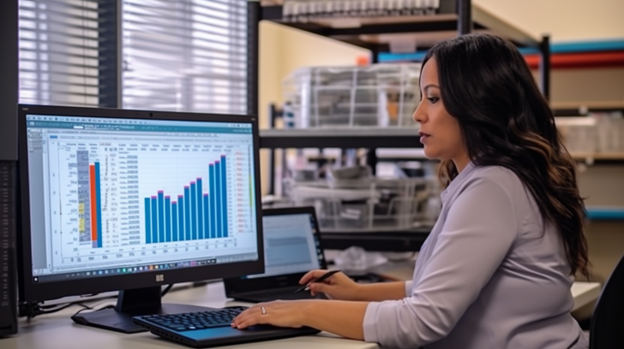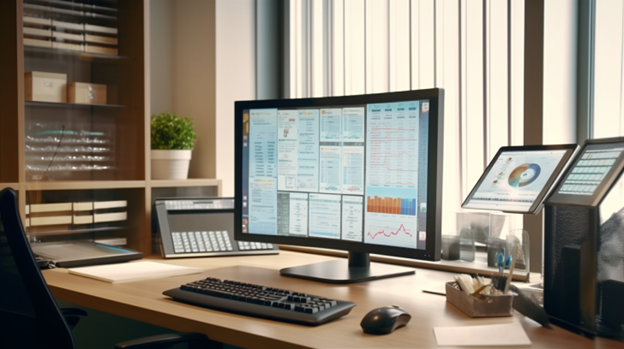
Navigating the complex world of R&D tax credits can be a daunting task for many businesses. However, understanding and preparing for an R&D tax credit audit can significantly impact a company’s ability to defend its credits and ultimately invest more in innovation. In this blog post, we will explore the intricacies of R&D tax credit audits, discuss the importance of proper documentation and compliance, and highlight the benefits of working with an R&D tax credit specialist. Armed with this knowledge, businesses can confidently navigate the audit process and maximize their R&D tax credit potential.
Short Summary
- Understand the R&D tax credit audit process and selection criteria for audits.
- Accurate, up-to-date documentation is essential to successfully pass an audit. Track employee time & wages, qualified supply expenses, contractor costs & agreements and computer rental/leasing expenses.
- Engage a specialist to ensure compliance with federal regulations related to research activities and successful outcomes during the audit process.
Understanding the R&D Tax Credit Audit Process
The R&D tax credit audit is an examination conducted by the IRS to review a taxpayer’s research tax credit claim. In this article, we will review the audit selection criteria, audit procedures, and potential outcomes of the R&D tax credit audit. As a taxpayer, it is crucial to be aware of these aspects to ensure a smooth and successful audit.
The responsibility of demonstrating that all section 41(d)(1) requirements have been met lies with the taxpayer, including documenting the technical uncertainties and alternatives evaluated. With a comprehensive R&D report and proper documentation, taxpayers can substantiate their development tax credit claim and navigate the complex audit process with confidence.
Selection Criteria for Audits
When it comes to R&D tax credit audits, it is essential to note that selection for an audit does not necessarily imply a problem or issue with a tax return. In fact, the IRS utilizes multiple techniques for selecting audits, including examining development costs. The IRS may base their selection on a statistical formula or established norms for similar returns derived from audits of a statistically valid random sample of returns.
By understanding the selection criteria and acknowledging that being chosen for an audit is not indicative of an issue, taxpayers can approach the audit process with a clearer perspective.
Audit Procedures and Focus Areas
The IRS begins an R&D tax credit audit with a standard notice requesting information about the books and records, qualified projects, expenses, and other documentation. The audit procedures generally involve a multi-step process where initial information gathered provides a basis for additional questions and documentation.
Some topics the IRS may focus on during an R&D credit audit include documentation, compliance with Qualified Research Activities (QRAs), and credit computations. Familiarizing oneself with these focus areas can help taxpayers be better prepared for the audit process and ensure a successful outcome.
Duration and Outcome of an Audit
The duration of an R&D tax credit audit will vary based on the complexity of the claim, the size of the company, caseload of the IRS agent, and the number of years being audited. As for the potential outcomes, the audit may result in adjustments to the claimed credit or no alterations whatsoever. In the event of an adjustment, a large adjustment may include penalties if the auditor deems the taxpayer has been egregious in their claim or failed to support the activities or expenses properly.
By understanding the possible duration and outcomes of an audit, taxpayers can be better prepared for the process and manage expectations accordingly.
Key Documentation Requirements for a Successful R&D Tax Credit Audit
Proper documentation is critical for a successful R&D tax credit audit. Essential documentation requirements include employee time and wage records, qualified supply expenses, contractor costs and agreements, and computer rental or leasing expenses. Ensuring that these records are accurate and up-to-date can significantly impact the outcome of the audit and help substantiate the taxpayer’s claim.
Organizing and maintaining these records is a key step in the process. It is important to do this.
Employee Time and Wage Records
Maintaining a reliable, comprehensive time-tracking system that links employee hours to particular activities is imperative for setting wages for R&D tax credit claims. In addition to a time-tracking system, it is necessary to allocate employee time between QRAs and non-QRAs for wage documentation.
By having a reliable time-tracking system and clear allocation of employee hours, taxpayers can provide the proper documentation for employee wages during an audit. While time-tracking is not required by law, it is strongly recommended that the taxpayer track hours to individual research projects and include documentation of completed tasks.
Qualified Supply Expenses
Qualified supply expenses encompass the cost of supplies used in qualified activities, such as extraordinary utilities, with the exclusion of capital items or general administrative supplies. Typical supplies include materials and small tools used to build pilot models. Documentation that supports the supplies used to construct pilot models or in testing a pilot model will help secure these expenses as part of the QREs.
By linking supply expenses to QRAs, taxpayers can effectively substantiate their claims during the audit process. A key to securing the supplies expense is documenting properly that the pilot model was used to eliminate uncertainties.
Contractor Costs
Internal Revenue Code Section 41 states that 65% of any sum paid or incurred by the taxpayer to contractors for research activities can be regarded as “contract research expenses” for the purpose of the R&D tax credit. To substantiate these expenditures, the relationship with the contractor must meet a series of tests to be included in the QREs. First, an agreement must be entered into before the beginning of any research. Second, the agreement provides that the research is being performed on the taxpayer's behalf. Third, it requires the taxpayer to bear the expense even if the research is unsuccessful. In practice, contracts that pay the contractor a fixed fee are typically excluded from QREs as the fixed fee transfers the risk of the research efforts to the contractor.
This documentation is essential for a successful R&D tax credit audit and can help support the taxpayer’s claim.
Computer Rental or Leasing Expenses
Computer Rental Expenses, like other qualified expense items, have specific requirements. For a computer rental expense to be included in the R&D credit claim, the expense must first be associated with a qualified development effort or project. In addition, the computer must be located off the taxpayer's premises, owned and operated by someone else, and the taxpayer must not be the computer's primary user.
By keeping accurate records of these expenses, taxpayers can ensure compliance with the IRS requirements and bolster their R&D tax credit claim.
Proving Compliance With Qualified Research Activities (QRAs)

To successfully claim the R&D tax credit, taxpayers must prove compliance with Qualified Research Activities (QRAs) by demonstrating that their research activities meet the four-part test. This test comprises eliminating technical uncertainty, ascertaining technological information, creating new or improved products/processes, and ensuring that at least 80% of research activities involve experimentation.
By understanding and adhering to the requirements of the four-part test, taxpayers can effectively qualify their research activities and successfully claim the R&D tax credit.
Eliminating Technical Uncertainty
Technical Uncertainty is a critical component of the four-part test for qualifying development activities.
Under the four-part test, Technical Uncertainty is defined as uncertainty related to the taxpayer's capability, method, or the appropriate design of the business component. In order to best document this test for a potential audit, taxpayers should document what information was missing at the beginning of the project relative to one of these aspects. As this test is performed at the onset or beginning of the project, meeting notes should be kept to memorialize these questions.
It should be noted that once the documented uncertainties have been resolved, qualified R&D stops on the business component and additional expenses will not qualify.
Discovering Technological Information
At the center of the R&D tax credit is the concept that research is undertaken to discover information that is technological in nature. This requirement is not as arduous as it first appears. In order to meet this requirement, the information being sought is considered technological in nature if the process of experimentation used to discover the information relies on the principles of the physical or biological sciences, engineering or computer science.
It is not a requirement that the taxpayer be seeking to obtain information that exceeds, expands, or refines the common knowledge of skilled professionals in their particular field of science.
Developing New or Improved Products/Processes

Research or development activities must attempt to develop or improve on business components for sale or use by customers.
What is a business component?
A business component is defined as a product, process, software, technique, formula, or invention. If the development is attempting an improvement, the improvement must be functional (rather than aesthetic).
Experimentation and Testing
The final aspect of the four-part test for R&D tax credit qualifying research activities is experimentation and testing. At least 80% of the research activities must involve elements of experimentation. The requirement ensures that the taxpayer is conducting research activities with alternatives considered and assessed. The research result is unpredictable at the start, which helps ensure the outcome or method of achieving it is well-designed.
By engaging in experimentation and testing, taxpayers can demonstrate compliance with the R&D tax credit requirements and strengthen their claims during the audit process.
Navigating Exclusions and Non-Qualifying Expenses

While the R&D tax credit offers significant benefits to taxpayers, it is essential to be aware of various exclusions and non-qualifying expenses. Understanding these exclusions can help taxpayers avoid claiming ineligible expenses and ensure compliance with the R&D tax credit requirements.
In this section, we will explore exclusions such as research after commercial production, adaptation and duplication of existing business components, and funded, foreign, and social science research.
Research After Commercial Production
Expenses incurred after the resolution of technical uncertainty are not eligible for the R&D tax credit. In practice, this means that once information needed to eliminate the technical uncertainties has been obtained and experimentation completed, expenses incurred after that time may not be included in the QREs.
Let's say, for example, technical uncertainties around the design of a new product are now eliminated and questions have surfaced related to the design of the manufacturing process. This process design initiative would be considered a new business component and could be evaluated separately from the product development effort.
By being aware of this exclusion, taxpayers can ensure that their claimed expenses are in compliance with the R&D tax credit requirements.
Adaptation and Duplication of Existing Business Components
Adaptations to existing business components are improvements or changes completed but do not meet the four-part test. More specifically, the changes need to have the necessary technical uncertainties and include a process of experimentation in order to qualify and do not.
Duplications of existing business components are also excluded from qualified R&D as they would not have the technical uncertainties needed to meet the four-part test.
By understanding this exclusion, taxpayers can avoid claiming ineligible expenses and maintain compliance with the R&D tax credit requirements.
Funded, Foreign, and Social Science Research
Funded research, foreign research, and social science research are excluded from the R&D tax credit. Development efforts supported by grants, contracts, or other means are considered funded research and are not eligible for credit.
More specifically, development efforts where the taxpayer does not have risk in the development (arguably because the customer or government is paying for it) or does not retain the rights to the results of the research are considered funded and excluded from the definition of qualified research. Contracts that are written for the delivery of a final product, compensated on a fixed fee, and where the taxpayer retains substantial rights to the development can qualify for R&D credits. This complex area of the R&D tax credit requires a detailed review of the contracts and should be performed by a knowledgeable professional.
Additionally, research conducted outside of the United States, regardless of whether it is performed by American researchers or for an American taxpayer, is considered foreign research and is also excluded.
By being aware of these exclusions, taxpayers can ensure compliance with the R&D tax credit requirements and avoid claiming ineligible expenses.
Surveys, Studies, and Market Research
Non-eligible R&D expenses include surveys, studies, market research, and routine data collection. These activities, while potentially valuable to a company’s overall research and development efforts, do not qualify for the R&D tax credit due to their nature.
By understanding and identifying these types of expenses, taxpayers can avoid claiming ineligible expenses and ensure compliance with the R&D tax credit requirements.
The Importance of Consistency and Accuracy in R&D Tax Credit Claims

Maintaining consistency and accuracy in R&D tax credit claims is of paramount importance. This ensures that the proper documentation is in place, credit computations are accurate, and common errors and red flags are avoided.
In this section, we will discuss the consistency rule, the need for accurate credit computations, and the importance of being aware of common errors and red flags in R&D tax credit claims.
The Consistency Rule
The consistency rule requires that QREs and gross receipts used to calculate the fixed base percentage are determined on a basis consistent with the determination of qualified expenses in the credit year. Documentation should be maintained to show consistency between the QREs in the credit year and QREs in the base years, as well as consistency between gross receipts in the base years and the four-year average. According to the IRS, taxpayers may not use extrapolations to determine base year expenses and should have supporting documentation such as financial statements and tax returns to support base year calculations.
By adhering to the consistency rule, taxpayers can better support the precise calculation of the R&D tax credit and prevent claiming the credit in excess.
Ensuring Accurate Credit Computations
Accurate credit computation is essential for a successful R&D tax credit claim. The IRS reviews the computation of R&D credits in audits, making it crucial for taxpayers to ensure that their calculations are accurate.
Accurate recordkeeping and documentation of R&D activities, as well as seeking counsel from an R&D specialist, can help taxpayers guarantee the precision of their credit computations and maximize their R&D tax credit potential.
Avoiding Common Errors and Red Flags
Taxpayers should be aware of common errors and red flags that may trigger an audit or result in adjustments to the claimed credit. These include misuse of grants, employee time, ownership, cloud & data costs, poor technical narrative, and failure to exclude an element of the costs attributable to help and support, or including software that is too far.
By being mindful of these common errors and red flags, taxpayers can best support their R&D tax credit claims and avoid potential issues during the audit process.
Working With an R&D Tax Credit Specialist

Working with an R&D tax credit specialist can provide numerous benefits, including expertise in R&D tax credit regulations, assistance in documentation and recordkeeping, and representation during the audit process. By engaging the services of an R&D tax credit specialist, businesses can confidently navigate the complex world of R&D tax credits and maximize their investment in research and development.
R&D tax credit specialists can provide invaluable guidance and support throughout the entire process.
Expertise in R&D Tax Credit Regulations
An R&D tax credit specialist can help navigate the intricate laws and regulations related to R&D tax credits, recognize and document legitimate R&D tax credit claims, and potentially augment investment in research and development. Their expertise in R&D tax credit regulations can assist companies in ensuring adherence to the federal tax laws and regulations pertaining to research and experimentation activities, as well as support them in recognizing and documenting qualifying activities.
By leveraging the expertise of an R&D tax credit specialist, businesses can ensure compliance with the R&D tax credit requirements and bolster their claims.
Assistance in Documentation and Recordkeeping
One of the key benefits of working with an R&D tax credit specialist is their ability to assist in documentation and recordkeeping for a successful audit. Proper documentation and recordkeeping are essential for guaranteeing precise credit computations for R&D tax credit claims.
An R&D tax credit specialist can provide direction on the activities that qualify for the R&D tax credit, in addition to ensuring the documentation is precise and comprehensive. This assistance can significantly impact the outcome of the audit and help substantiate the taxpayer’s claim.
Representation During the Audit Process
An R&D tax credit specialist can provide valuable representation during the audit process, offering guidance and support to the taxpayer. Their expertise in R&D tax credit regulations, along with their experience in navigating the audit process, can prove invaluable to businesses facing an R&D tax credit audit.
By engaging an R&D tax credit specialist, businesses can confidently approach the audit process and maximize their R&D tax credit potential.
Summary
Understanding and preparing for an R&D tax credit audit is crucial for businesses looking to maximize their R&D tax credits and invest in innovation. By familiarizing oneself with the audit process, ensuring proper documentation and compliance, and working with an R&D tax credit specialist, businesses can confidently navigate the complex world of R&D tax credits and unlock their full potential. Embrace the power of research and development, and let innovation drive your business to new heights.
Frequently Asked Questions
What if an employee spends 80% or more of their time on qualified R&D projects?
If 80% or more of an employee's time is spent conducting qualified R&D tasks, 100% of their W-2 wages may be included in the QREs.
How much R&D tax credit can I receive for my qualified expenses?
While the R&D credit regulations note the credit is 20% of a taxpayer's qualified expenses, limitations built into the calculation result in approximately 6-8% credit of the qualified expenses.
This is a great way for companies to reduce their tax burden and invest in research and development.
What are the four tests performed to qualify a development activity?
As noted above, activities completed must be for the development or improvement of a business component that requires a process of experimentation to resolve technical uncertainties. The process of experimentation must rely on the principles of science.
What does not qualify as R&D?
While the R&D credit regulations identify specific activities that are excluded from qualified R&D, if an activity does not pass the four-part test, the time spent would not qualify as R&D.



